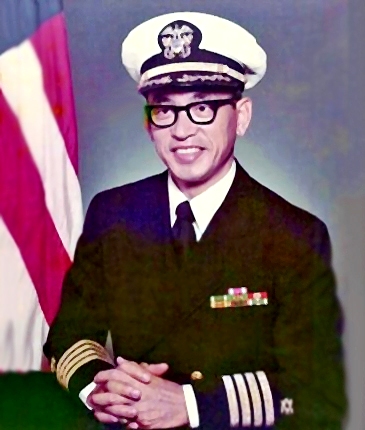 Captain Takeshi "Tak" Yoshihara, USN, (Ret.), died in Honolulu, HI, on 25 June 2020. He was 89 years old.
Captain Takeshi "Tak" Yoshihara, USN, (Ret.), died in Honolulu, HI, on 25 June 2020. He was 89 years old.Tak was born on May 14, 1931, at Selleck, Washington, where he spent his early childhood years. In 1942, following Japan's attack on Pearl Harbor, his family was relocated to the Minidoka Relocation Center in Idaho where they were interned during the WW II years. After their release in September 1945, Tak attended Renton High School in the state of Washington, graduating in 1949, voted by his classmates to give the graduation speech.
He entered the U.S. Naval Academy in the summer of 1949, and graduated with distinction in 1953. A pioneer in his own right he became the first Japanese-American graduate from the U.S. Naval Academy. Subsequent to graduation he was assigned to the Navy Bureau of Yards and Docks at Port Hueneme, California. He served for 2l years in various assignments to Midway Island, Pearl Harbor, Port Hueneme and Virginia with the Navy Civil Engineer Corps before his retirement in 1974. He is a Vietnam veteran.
During his naval service he earned four academic degrees in addition to the BS from the Naval Academy: BS (civil engineering) from Rensselaer Polytechnic Institute; MS and PhD (civil engineering) from the University of Illinois; and MBA from George Washington University.
Upon retirement from the U.S. Navy, he accepted a faculty position at the University of Hawaii where he taught civil engineering for three years. His subsequent work experience included Senior Advisor to U.S. Senator Spark Matsunaga in Washington, DC; Director (Pacific) of the U.S. Department of Energy: Director of Energy for the State of Hawaii; and Deputy Director of Business and Economic Development, State of Hawaii.
Notably during his tour in Vietnam he was formally recognized for being responsible for administration of the planning, design, and construction of ALL military programs in the Republic of Vietnam. A highpoint in that tour was oversight of the building of the Danang Airfield. While in support of the Office of Naval Research (ONR) he conducted the programming and defended the initiative establishing the Naval Arctic Research Laboratory as an official naval shore activity at Point Barrow, Alaska. During his tenure in Federal and State positions in Hawaii he was on the ground floor leading the initiatives to bring alternative energy sources to the islands in the 1980's: Ocean Thermal Energy Conversion (OTEC), Geothermal, Solar and Wind. The solar maps (40 years later) still retain his signature from his commissioned study on photovoltaic energy, and are used to this day in positioning solar panels within the state of Hawaii.
He is survived by his wife of 67years, the former Elva Uyeno, of Honolulu, Hawaii; sons Peter (Adrienne) and David (Chiaki); and two grandsons, Andrew (Angel) and Timothy, and great-grandson Elijah. He lived a life of gratitude to God for His blessings, and to his family, shipmates, and friends for their enduring love and devotion.
Private memorial services and inurnment at the National Memorial Cemetery of the Pacific are yet to be determined.
Arrangements Provided By:
Hosoi Garden Mortuary



